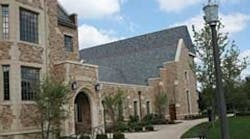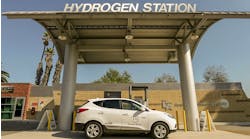An increasing number of districts and campuses require LEED certification for major construction projects. In addition, some academic institutions require LEED equivalency but not certification, and others have developed their own sustainable building guidelines.
But many institutions still object to LEED certification because they believe it will cost more to construct and certify. Research indicates that LEED-certified projects may come in under budget (like other well-managed projects)—or may cost 1 to 2 percent more. These additional costs may be partially or fully recouped in lower operating and maintenance costs over the life cycle of the building or through energy efficiencies.
The cost of LEED registration and certification averages $2,000 per project, according to a recent study, "To LEED or Not to LEED—A Review of Green Policies in Higher Education," by Karl E. Knapp and Christina Liebner. In addition, estimates of internal and consultant costs range from $50,000 to $100,000 per LEED building.
Regardless of these additional costs, managing construction to keep spending in check on a LEED-registered building requires strategies similar to those used to manage any other education construction project.
What drives costs?
The major factors driving construction costs—LEED-registered projects included—are the total volume and size of a new project, the existing construction market, geographic area and climate, and intended use and programming of the building. In addition, facilities need to meet current and future needs; therefore, flexibility and expandability often are crucial and must be considered in terms of present and future costs.
In an ideal scenario, a project team designs and builds flexibility and expandability into a building without increasing its footprint or volume. Incorporating multiuse spaces is an example of this. Achieving these goals also may entail increasing the size of building systems or extending utilities to accommodate future growth. Although these solutions tend to increase initial capital costs, they usually are a cost-effective way to reduce the future cost of a multi-phase expansion—if the education institution has the financial capability to make the additional upfront investment.
Green strategies
A project team experienced in the planning, design and construction of the specific type of academic facility should be able to effectively manage costs. If an institution is going to seek LEED certification, it is essential to commit to that goal at the outset to avoid costly redesign work. Select a project team that is experienced in the pertinent LEED certification rating system and process. The team also should include at least one LEED-accredited professional.
The construction manager will be directly responsible for earning several LEED credits pertaining to construction planning and activities. In addition, the contractor will be responsible for documenting about 25 percent of the total LEED credits. Therefore, it is essential to select a construction manager experienced with LEED certification of education facilities.
In today’s economy, it is a buyer’s construction market. This is good news for education institutions with projects in the design phase. That said, it is essential for an institution to select a contractor with the procurement experience and qualification procedures in place to select well-qualified bidders—not merely the low bidders.
Preconstruction services
An experienced construction company’s understanding of project documents, constructability and logistics will help a project management team manage schedule, quality and, ultimately, cost. Engaging a contractor in the preconstruction phase enables this firm to develop project cost estimates and budgets based on a full, written scope of work, and accurate historical and present-day market data.
Throughout the design phases, a contractor also will identify issues associated with constructability, logistics, building systems and materials, and propose cost-effective alternatives. This is particularly important for small building sites, which are the norm on most academic campuses. During the construction phase, a contractor’s project manager is responsible for effectively managing the construction process so that it is completed safely, on time and within budget.
For a LEED-registered project, the contributions of a contractor are significant. First, the estimator can develop a life-cycle cost analysis, which projects the long-term return on investment derived from a high-performance education facility. An understanding of the intent of the LEED design also is critical in procuring the right vendors, equipment and installation methods.
A contractor also will plan and manage the processes that directly affect LEED certification, including managing the required documentation for submission to the Green Building Certification Institute (GBCI), which administers certification through a network of third-party professionals.
In addition, commissioning is crucial to proper completion of a LEED-registered project. About 10 to 15 percent of total LEED credits depend upon building system commissioning. The construction company or third-party commissioning agent must ensure that every building system is installed properly and fully tested, and commissioning documents are completed as the project progresses.
A green alternative?
Education institutions may wish to consider the pros and cons of pursuing formal LEED certification. Some may decide to meet a LEED-equivalent high-performance building standard without formally certifying the building. The Association for Advancement of Sustainability in Higher Education, an association of colleges and universities that are working on sustainability issues, has a wealth of information on facilities as well as governance, education and research.
Evaluating an institution’s motivating factors for pursuing a sustainable facility also is helpful. A comparison of the institution’s goals with those that are identified in LEED certification requirements would be a good first step in considering whether the two sets of priorities are aligned. A LEED-certified building is designed to save energy, use water efficiently, reduce carbon-dioxide emissions, improve indoor environmental quality and promote stewardship of natural resources. The LEED rating systems provide schools and universities with a clear framework for identifying and carrying out sustainable design, construction, operations and maintenance—and measuring the results.
Additional costs are associated with registering and certifying a project. Some of the main issues to consider are what long-term efficiencies a sustainable design would provide and what benefits the institution might derive from obtaining a LEED certification. A LEED-rated building may be a deciding factor for students looking to enroll in an institution that demonstrates environmental stewardship. In addition, an institution may be eligible for economic incentives for designing and building a LEED-certified facility.
- Read the "Ryan Hall, University of Notre Dame, Goes Green" sidebar to learn about how Ryan Hall at the University of Notre Dame went green.
Korte, LEED AP, is a project manager with Skanska USA Building Inc., Portage, Mich. He can be reached at [email protected] .



